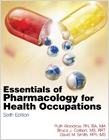Description: Essentials of Pharmacology for Health Occupations, 6th Edition provides an extensive framework of drug information in a concise format for learners studying licensed practical nursing, medical assisting and other allied health professions. Learn calculations quickly through a simplified step-by-step process. Discover key drug information by classifications, such as their purpose, side effects, cautions, and interactions, or utilize this resource to refresh your knowledge of drugs. The accompanying CD-ROM helps learners master pharmacology through quizzes, games, and case studies with immediate feedback and medication administration techniques and safety video clips. Open this resource now and see how easy learning pharmacology can be. Product Benefits: - NEW Studyware Connection directs learner to additional learning opportunities such as quizzes, case studies, medication administration techniques and safety videos, drug label exercises, and other interactive games included on the accompanying Studyware CD-ROM
- NEW quizzes with NCLEX-style questions and an audio library of generic and trade name drugs and general pharmacology terms are featured on the accompanying Studyware CD-ROM
- The most common and/or most important side effects of drugs are highlighted with a special icon that serves as a valuable guide for learners.
- Patient Education is summarized and highlighted for each classification of drugs. These special boxes will assist health care workers to instruct patients on and answer questions about the medications they are taking.
- Case Studies stimulate critical thinking through the presentation of reality-based situations regarding drug usage.
Table of Contents: PART 1: INTRODUCTION
1. Consumer Safety and Drug Regulations.
Drug Laws. FDA and DEA. Health Care Workers and the Law.
2. Drug Names and References.
Classifications. Identifying Names. Legal Terms Referring to Drugs. Terms Indicating Drug Actions. Drug References. The Internet as Reference. Drug Cards.
3. Sources and Bodily Effects of Drugs.
Sources of Drugs. Effects of Drugs. Drug Processing by the Body (Pharmacokinetics). Absorption. Distribution. Metabolism. Excretion. Other Variables. Unexpected Responses to Drugs.
4. Medication Preparations and Supplies.
A Space-Age Drug Form. Standard Drug Forms. Supplies.
5. Abbreviations and Systems of Measurement.
Abbreviations. Systems of Measurement.
6. Safe Dosage Preparation.
Basic Arithmetic Test. Calculation Guidelines. Method 1: Basic Calculation.
Method 2: Ratio and Proportion. Pediatric Dosage. Geriatric Dosage. Prevention of Medication Errors.
7. Responsibilities and Principles of Drug Administration.
Responsible Drug Administration. Medication Errors. Principles of Administration.
8. Administration by the Gastrointestinal Route.
Administration of Medications Orally. Administration of Medications by Nasogastric Tube. Administration of Medications by Gastric Tube. Administration of Medications Rectally.
9. Administration by the Parenteral Route.
Sublingual and Buccal Administration. Transcutaneous Drug Delivery System. Inhalation Therapy. Injections. Skin Medications. Application to the Mucous Membranes. Eye Medications.
10. Poison Control.
Poisoning by Ingestion. Poisoning by Inhalation. External Poisoning of Skin or Eyes. Poisoning by Sting and Snakebite. People at Risk.
PART II: DRUG CLASSIFICATIONS.
11. Vitamins, Minerals, and Herbs.
Fat-Soluble Vitamins. Water-Soluble Vitamins. Minerals. Antioxidants. Alternative Medicines. References. Online References.
12. Skin Medications.
Antipruritics. Corticosteroids. Emollients and Demulcents. Keratolytics. Scabicides and Pediculicides. Antifungals. Antivirals. Local Anti-Infectives. Agents Used to Treat Acne. Cautions for Topical Medications.
13. Autonomic Nervous System Drugs.
Adrenergics. Adrenergic Blockers. Cholinergics. Cholinergic Blockers.
14. Antineoplastic Drugs.
Antimetabolites. Alkylating Agents. Plant Alkaloids. Antibiotic Antineoplastics. Hormone Therapy. Biological Response Modifiers. Monoclonal Antibodies. Radioactive Isotopes. Cautions and Responsibilities for Antineoplastic Drugs.
15. Urinary System Drugs.
Diuretics. Medications for Gout. Antispasmodics. Cholinergics. Analgesics. Treatment of Benign Prostatic Hypertrophy (BPH). Alpha-Blockers.
16. Gastrointestinal Drugs.
Antacids. Agents for Treatment of Ulcers and Gastroesophageal Reflux Disease. Antispasmodics/Anticholinergics. For Inflammatory Bowel Disease. Antidiarrhea Agents. Antiflatulents. Laxatives and ... |

